蛾眉天体的近合
See Explanation. Clicking on the picture will download the highest resolution version available.
请参阅说明。单击图片将下载可用的最高分辨率版本。

See Explanation. Clicking on the picture will download the highest resolution version available.
请参阅说明。单击图片将下载可用的最高分辨率版本。

2023年3月25日 Venus and the Da Vinci Glow Image Credit & Copyright: Giorgia Hofer Explanation: On March 23 early evening skygazers could watch Venus and a young crescent moon, both near the western horizon. On that date Earth’s brilliant evening star, faint lunar night side and slender sunlit crescent were captured in this telephoto skyscape posing alongside a church tower from Danta di Cadore, Dolomiti, Italy. Of course the subtle lunar illumination is earthshine, earthlight reflected from the Moon’s night side. A description of earthshine, in terms of sunlight reflected by Earth’s oceans illuminating the Moon’s dark surface, was written over 500 years ago by Leonardo da Vinci. On March 24, from some locations the Moon could be seen to occult or pass in front of…
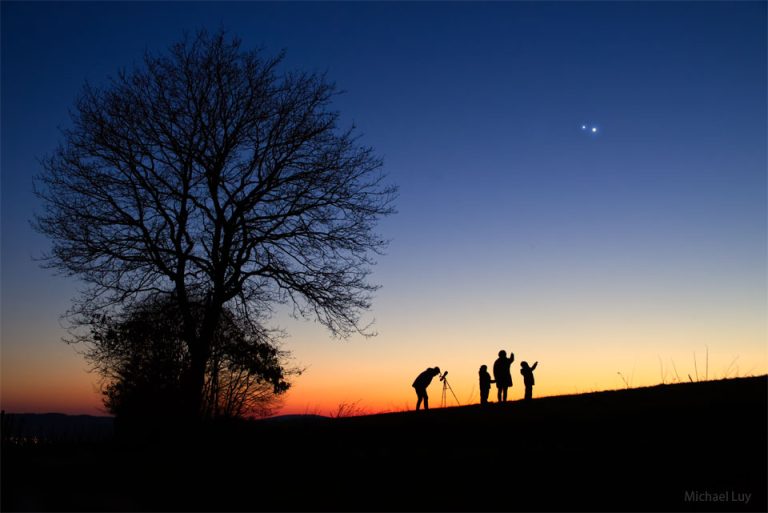
2023年3月15日 Jupiter and Venus Converge over Germany Image Credit & Copyright: Michael Luy (Trier Observatory) Explanation: This was a sky to show the kids. Early this month the two brightest planets in the night sky, Jupiter and Venus, appeared to converge. At their closest, the two planets were separated by only about the angular width of the full moon. The spectacle occurred just after sunset and was seen and photographed all across planet Earth. The displayed image was taken near to the time of closest approach from Wiltingen, Germany, and features the astrophotographer, spouse, and their two children. Of course, Venus remains much closer to both the Sun and the Earth than Jupiter — the apparent closeness between the planets in the sky of Earth…

2023年3月5日 Jupiter and Venus over Italy Image Credit & Copyright: Giovanni Tumino Explanation: What are those two bright spots? Planets. A few days ago, the two brightest planets in the night sky passed within a single degree of each other in what is termed a conjunction. Visible just after sunset in much of the world, the two bright spots were Jupiter (left) and Venus (right). The featured image was taken near closest approach from Cirica, Sicily, Italy. The week before, Venus was rising higher in the sunset sky to meet the dropping Jupiter. Now they have switched places. Of course, Venus remains much closer to both the Sun and the Earth than Jupiter — the apparent closeness between the planets in the sky of Earth…

2023年3月4日 10 Days of Venus and Jupiter Image Credit & Copyright: Soumyadeep Mukherjee Explanation: Venus and Jupiter may have caught your attention lately. The impending close conjunction of the two brightest planets visible in clear evening skies has been hard to miss. With Jupiter at the top, starting on February 21 and ending on March 2, their close approach is chronicled daily, left to right, in these panels recorded from Dhanbad, India. Near the western horizon, the evening sky colors and exposures used for each panel depend on the local conditions near sunset. On February 22, Jupiter and Venus were joined by the young crescent Moon. The celestial pair appeared to be only the width of a full moon apart by March 2. Of course…
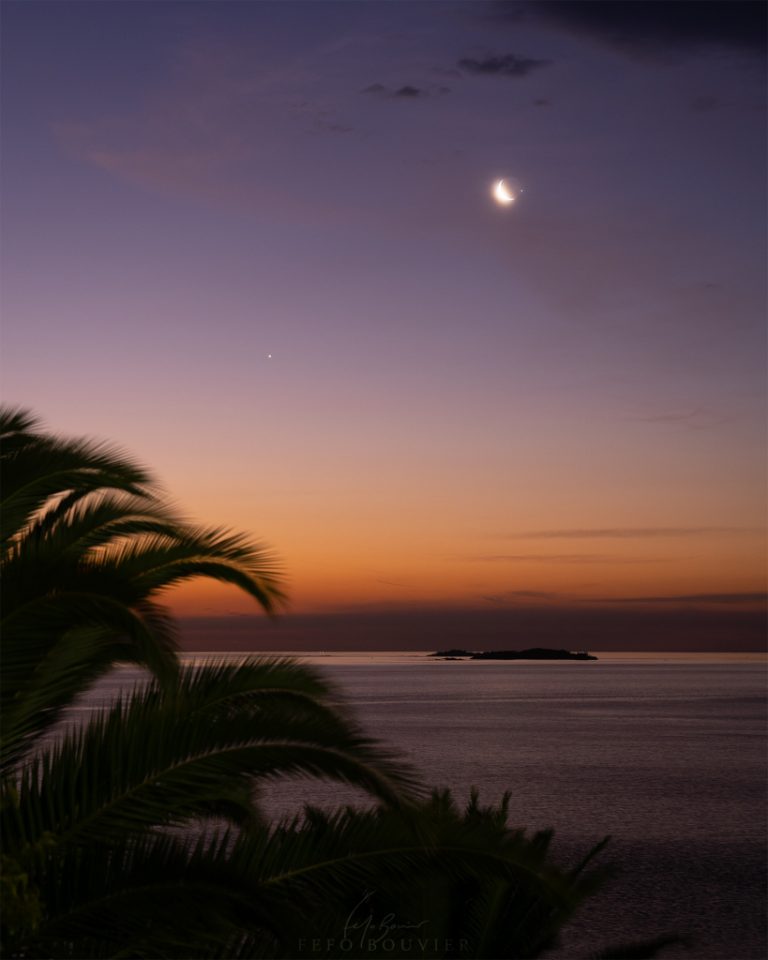
2023年2月25日 Crescent Moon Occultation Image Credit & Copyright: Fefo Bouvier Explanation: On February 22, a young Moon shared the western sky at sunset with bright planets Venus and Jupiter along the ecliptic plane. The beautiful celestial conjunction was visible around planet Earth. But from some locations Jupiter hid for a while, occulted by the crescent lunar disk. The Solar System’s ruling gas giant was captured here just before it disappeared behind the the Moon’s dark edge, seen over the Río de la Plata at Colonia del Sacramento, Uruguay. In the serene river and skyscape Venus is not so shy, shining brightly closer to the horizon through the fading twilight. Next week Venus and Jupiter will appear even closer in your evening sky. Tomorrow’s picture: Saturn’s…
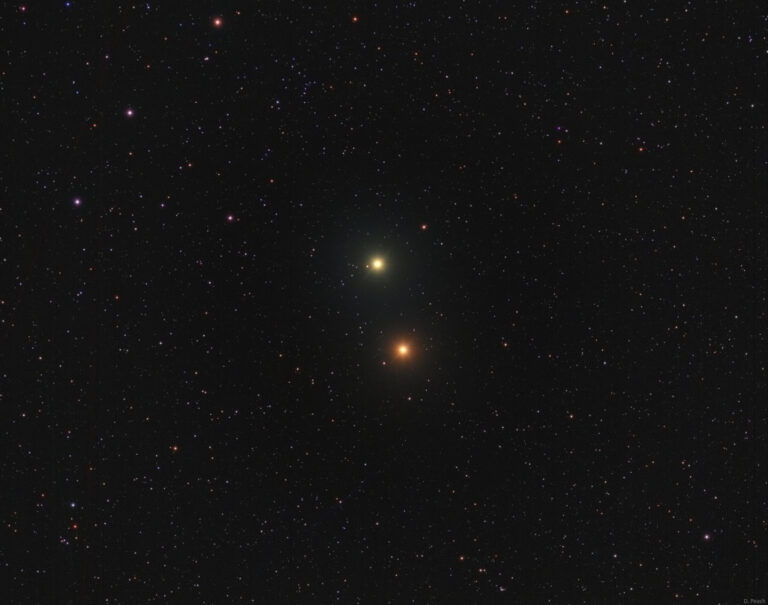
2022年4月9日 Mars-Saturn Conjunction Image Credit & Copyright: Damian Peach Explanation: Fainter stars in the zodiacal constellation Capricornus are scattered near the plane of the ecliptic in this field of view. The two brightest ones at center aren’t stars at all though, but the planets Mars and Saturn. Taken on the morning of April 4, the telescopic snapshot captured their tantalizing close conjunction in a predawn sky, the pair of planets separated by only about 1/3 of a degree. That’s easily less than the apparent width of a Full Moon. Can you tell which planet is which? If you guessed Mars is the redder one , you’d be right. Above Mars, slightly fainter Saturn still shines with a paler yellowish tinge in reflected sunlight. Even at…
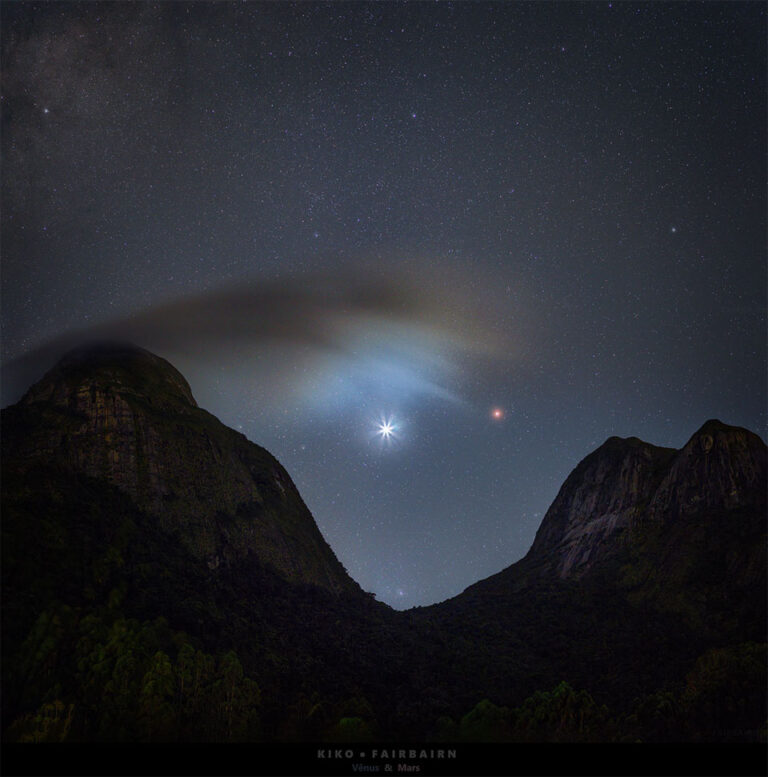
2022年3月29日 Venus and Mars: Passing in the Night Image Credit & Copyright: Carlos Kiko Fairbairn Explanation: When two planets pass on the night sky, they can usually be seen near each other for a week or more. In the case of this planetary conjunction, Venus and Mars passed within 4 degrees of each other earlier this month. The featured image was taken a few days prior, when Venus was slowing rising in the pre-dawn sky, night by night, while Mars was slowly setting. The image, a four-part mosaic, was captured in Brazil from the small town Teresópolis. Besides Venus and Mars, the morning sky now also includes the more distant planet Saturn. Of course, these conjunctions are only angular — Venus, Mars, and Saturn continue…

2021年7月16日 Love and War by Moonlight Image Credit & Copyright: Shi Huan Explanation: Venus, named for the Roman goddess of love, and Mars, the war god’s namesake, come together by moonlight in this serene skyview, recorded on July 11 from Lualaba province, Democratic Republic of Congo, planet Earth. Taken in the western twilight sky shortly after sunset the exposure also records earthshine illuminating the otherwise dark surface of the young crescent Moon. Of course the Moon has moved on. Venus still shines in the west though as the evening star, third brightest object in Earth’s sky, after the Sun and the Moon itself. Seen here above a brilliant Venus, Mars moved even closer to the brighter planet and by July 13 could be seen only…
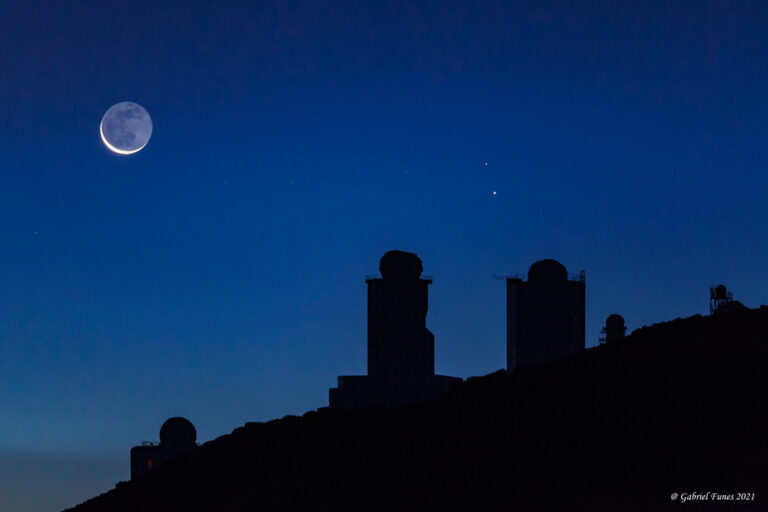
2021年7月10日 Mercury and the Da Vinci Glow Image Credit & Copyright: Gabriel Funes Explanation: On July 8th early morning risers saw Mercury near an old Moon low on the eastern horizon. On that date bright planet, faint glow of lunar night side, and sunlit crescent were captured in this predawn skyscape from Tenerife’s Teide National Park in the Canary Islands. Never far from the Sun in planet Earth’s sky, the fleeting inner planet shines near its brightest in the morning twilight scene. Mercury lies just below the zeta star of the constellation Taurus, Zeta Tauri, near the tip of the celestial bull’s horn. Of course the Moon’s ashen glow is earthshine, earthlight reflected from the Moon’s night side. A description of earthshine, in terms of…